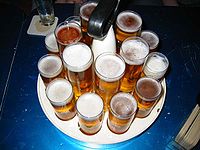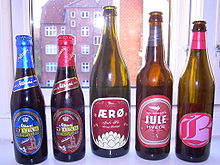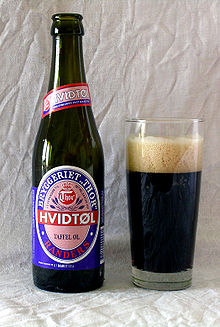- Beer in Denmark
-
Beer in Denmark is dominated by Carlsberg and Tuborg. Since Tuborg was acquired by Carlsberg in 1970 this has left a near monopoly for Carlsberg. A number of regional breweries however managed to survive, and most of them merged to Royal Unibrew in 2005. Also in recent years a large number of micro breweries have appeared.
Contents
Economy
The Danish market is dominated by pale lager, with more than 95% of total sales. However, stout and other dark beers are increasing in popularity, a trend driven by the market growth of premium-priced beers. The local microbreweries are strong innovators and produce a wide variety of beer styles, including strong IPAs and stouts.[1]
Danish beer production was 723 million litres in 2001, and increased to 870 million litres by 2005. This is an increase of 20%.
Imported beer accounted for only 8% of total volume sales in 2006. This indicates that beer sales in Denmark are dominated by domestic brands; however, imports increased by 14% in 2006 to reach 36.3 million litres. Germany is the most important source market for imports.
Danish beer exports was 296.1 million litres in 2006. Germany continues to be the most important export market for Danish beers. The German market accounted for 30% of exports in 2006.
Based on data from the Danish Beer Association (Bryggeriforeningen), beer consumption for 2005 was 539 million litres.[2]
Jacobsen
Danish industrialist J. C. Jacobsen revolutionized the world of brewing when his brewery, Carlsberg, bred a pure strain of lager yeast, Saccharomyces carlsbergensis. This enabled the breweries to achieve a large and consistent output, and lager has been the most popular style of beer in Denmark since Carlsberg started selling it in 1847.[3] Smaller breweries in Denmark suffered greatly under the Carlsberg market dominance, especially during the middle of the 20th century, and this led to a large reduction in available beer quality and styles. In recent years the interest in higher quality beer has risen sharply, and the Danish beer landscape is now dotted with several small breweries and brewpubs, producing a wide range of beers.
Common Types of Beer
Classic
An all malt pale lager with more colour and taste. The classic type is named after the Tuborg Classic. For instance: Tuborg Classic, Tuborg Classic Gylden, Carl's Special, Royal Classic
Guld
Guld (Gold) is a name commonly applied to pale lagers with a strength around 5.7% abv. Examples include: Tuborg Guld (5.8%), Carlsberg Sort Guld (5.8%), Svaneke Mørk Guld (5.7%), and Wiibroe Guld Export (5.7%).
Hvidtøl
Hvidtøl (White beer) is a traditional Danish beer. It is usually under 2% abv, and quite malty and sweet. It was once the most common beer in Denmark but sales have declined so that it is mainly only bought at Christmas when it is served with rice pudding.[4] The beer was originally termed "white" as it was made from kilned malt, which was developed in the late 18th century in contrast to the malts dried over fires which produced smokey beers.[5]
Julebryg
Julebryg and Juleøl (Christmas beer) are names given to beers marketed at Christmas. They vary in strength and style, though tend to be malty and around 6% abv. Examples include Tuborg Julebryg (a 5.6% pale lager), Svaneke Julebryg (a 5.6% dark lager), Fur Julebryg (a 6.5% brown ale), Fjordens Juleøl (a 6% dark lager), and Raasted Juleøl (a 8.5% dark ale).
Nisseøl
Nisseøl (literally elf beer) is a dark, sweet hvidtøl (white beer) which is sold around Christmas time in Denmark. The name come from the nisser (mythical creatures of Scandinavian folklore) who are often depicted on the beer labels. It is not to be confused with julebryg, which is a much stronger Danish Christmas beer.
Påskeøl
Påskeøl (Easter beer) is usually tax category II strength beer. Examples include: Carl's Påske, Tuborg Påskebryg, Royal Spring.
Pale lager
The most common type of beer in Denmark is pale lager, simply known as Pilsner in Danish. For instance: Carlsberg Pilsner, Grøn Tuborg, Royal Pilsner.
Strong Lager
Strong Lager (Stærk Øl or Export) refers to pale lagers in the tax category III (6-8%) beers such as Carlsberg Elephant Beer, Tuborg Fine Festival, Royal Selection.
Breweries
- Carlsberg
- Tuborg
- Wiibroe
- Royal Unibrew
- Albani Brewery
- Ceres Brewery
- Faxe Brewery
- Maribo Bryghus
- Thor Bryghus
- Fuglsang
- Hancock Breweries
- Harboe Brewery
- Thisted Bryghus
- Vestfyen
- Ørbæk
- Nørrebro Bryghus
See also
- Category:Beer and breweries in Denmark
References
Notes
- ^ [1] RateBeer brewery directory. Retrieved 31 August 2008
- ^ [2] euromonitor.com. Retrieved 31 August 2008
- ^ [3] Guardian.co.uk, Roger Protz, Arts that others don't reach..., The Observer, Sunday February 11, 2001. Retrieved 31 August 2008
- ^ [4]
- ^ The Beer of the Danish Golden Age, Rolf Nielson, Scandinavian Brewers Review, Vol 65, No 4, 2008, pp 12 - 21.
Literature
- Kristof Glamann, Beer And Brewing In Pre-Industrial Denmark, University Press of Southern Denmark, 2005. ISBN 9788776740689.
External links
Danish beer Beer brands Major breweries OthersBryggeriet Vestfyen A/S · Harboes Bryggeri A/SMicrobreweries 1 formerly "Vores Øl"Beers of the world Africa 
Asia Europe Americas Oceania Beer and breweries by region · List of countries by beer consumption per capita · Alcohol belts of EuropeCategories:- Beer and breweries in Denmark
- Economy of Denmark
- Carlsberg
Wikimedia Foundation. 2010.


